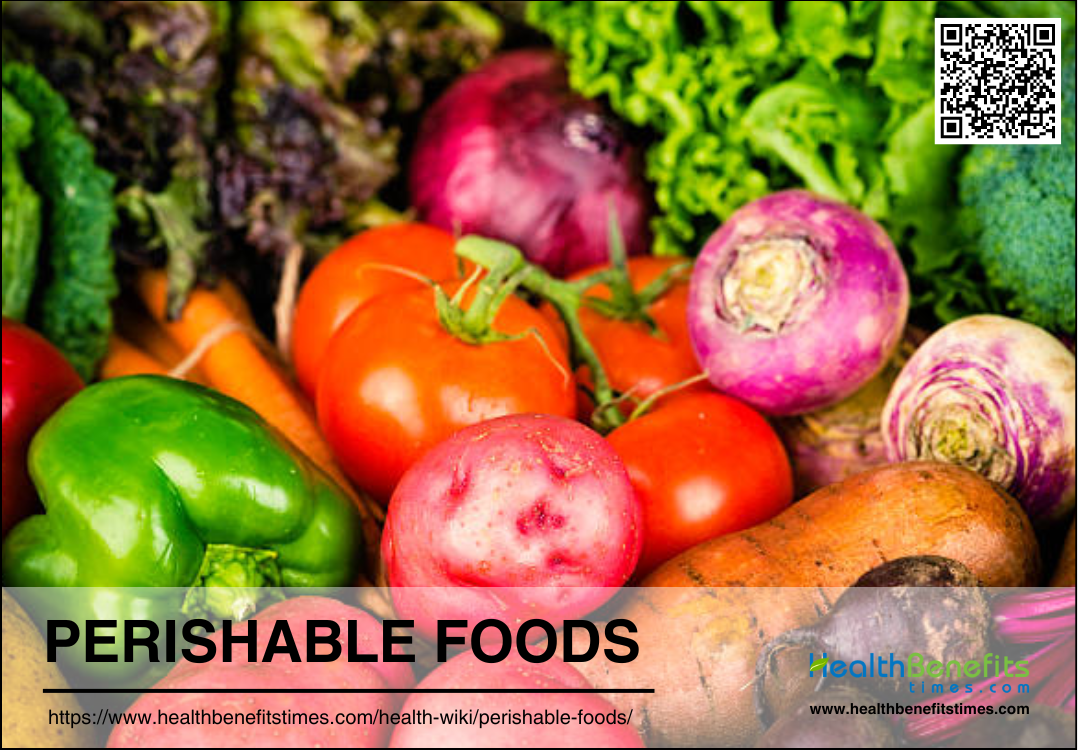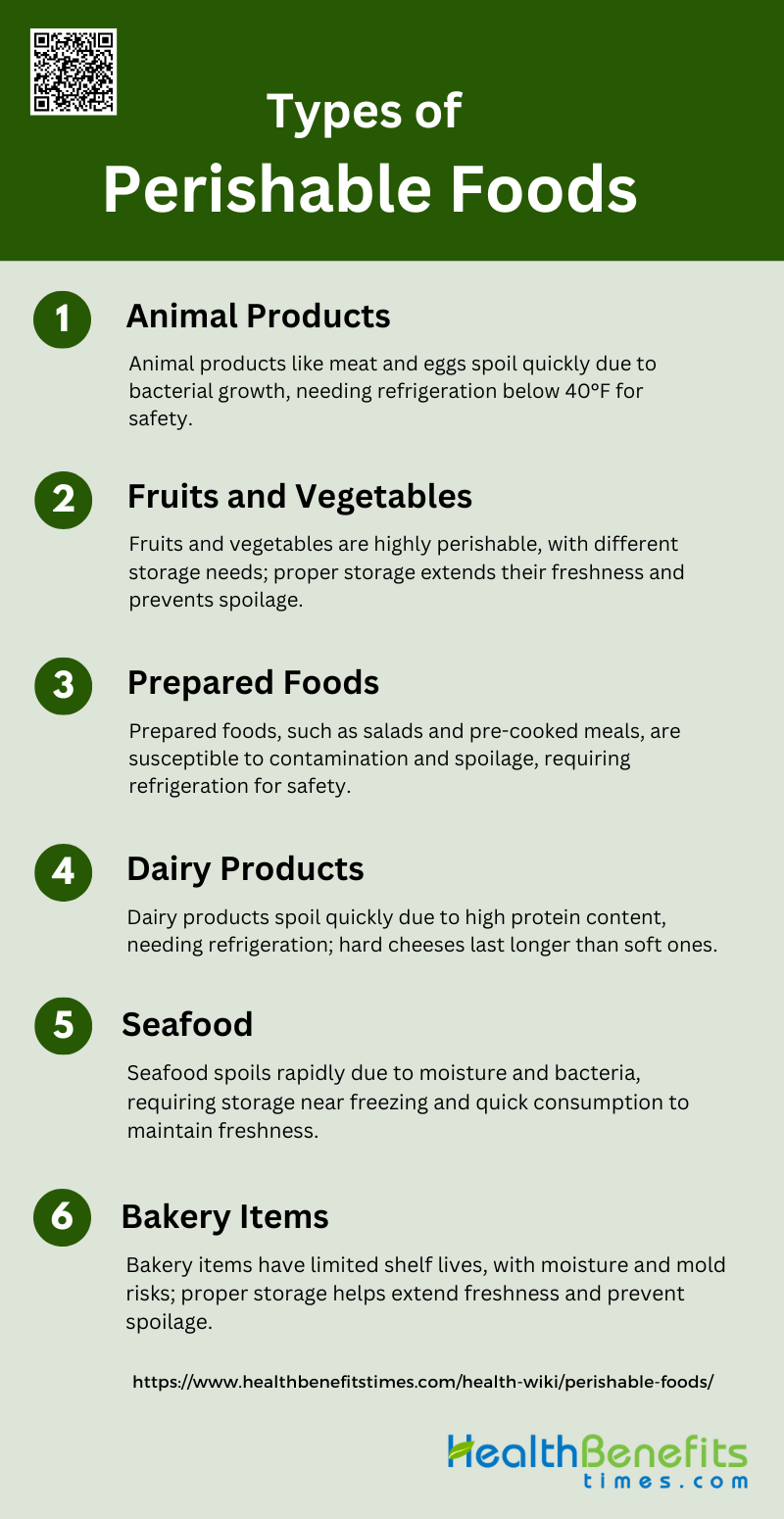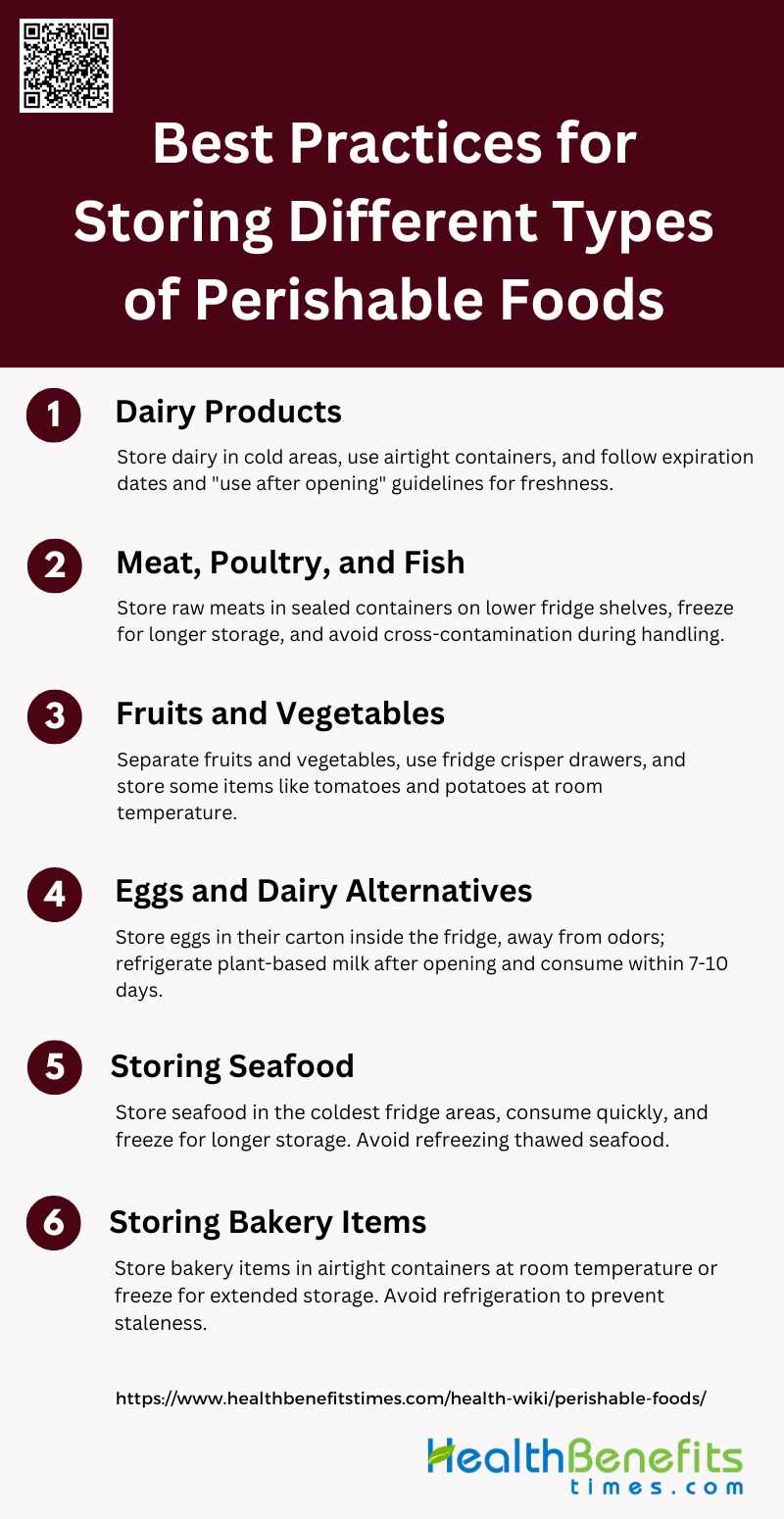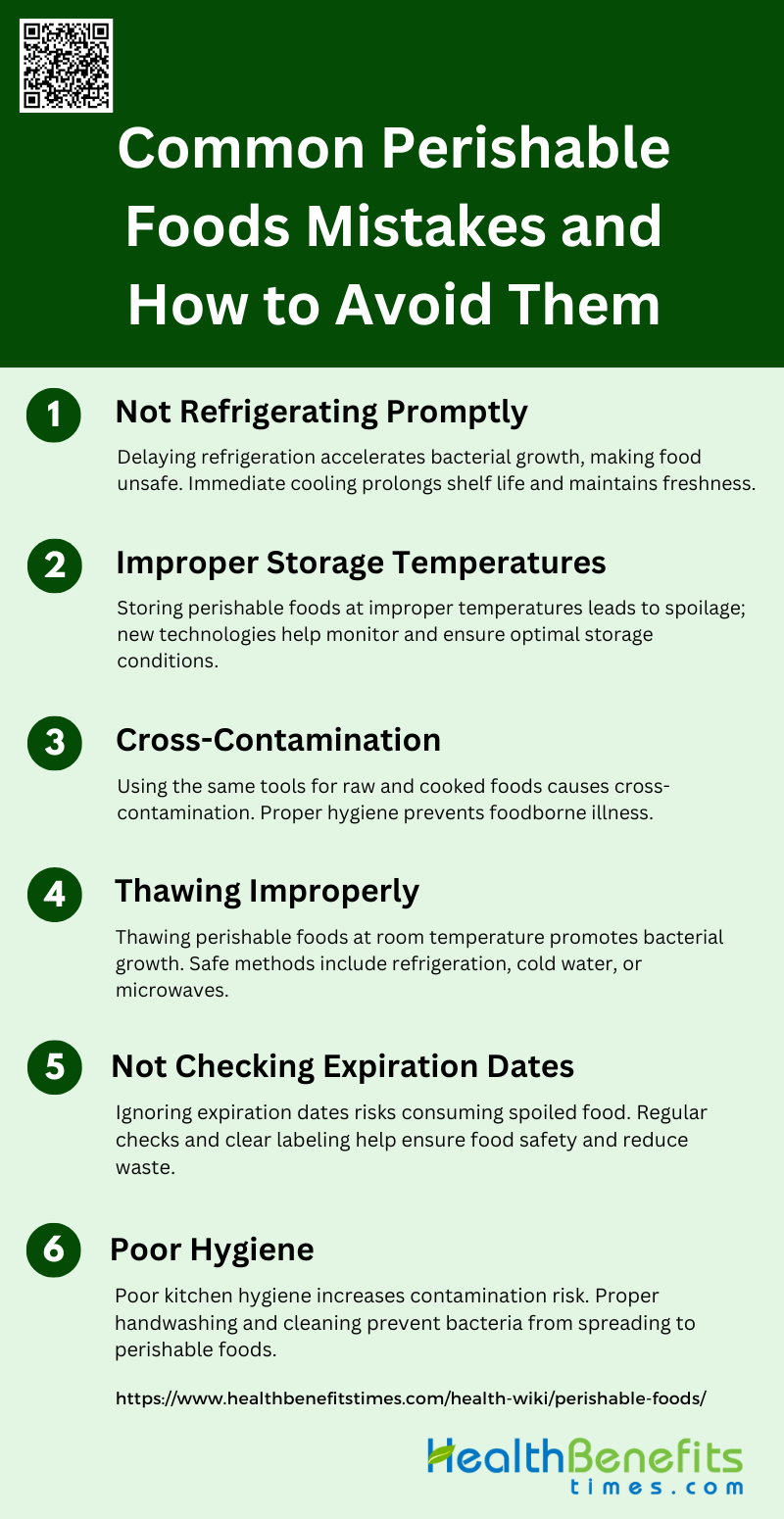Perishable foods are items that have a limited shelf life and require specific handling and storage conditions to maintain their quality and safety. These foods include meats, poultry, eggs, milk and dairy products, delicatessen items, fruits, vegetables, and seafood. Due to their short lifespan, perishable foods are prone to spoilage and foodborne illnesses if not managed properly. Effective strategies for handling perishable foods involve maintaining proper sanitation, using dynamic pricing to reduce waste, and employing advanced preservation techniques such as edible coatings and controlled atmosphere packaging. The cold supply chain plays a crucial role in extending the shelf life of these products by ensuring they are kept at appropriate temperatures during transport and storage.
Types of perishable foods
Perishable foods are items that spoil quickly and require proper storage to maintain their freshness and safety. These foods are essential in our daily diet but need careful handling to prevent waste and foodborne illnesses. Below are various types of perishable foods:
1. Animal Products
Animal products are highly perishable foods that require careful handling and storage. This category includes fresh meats such as beef, pork, and poultry, as well as eggs. These items are rich in proteins and fats, making them susceptible to bacterial growth and spoilage. Proper refrigeration is crucial to maintain their quality and safety. Raw meats should be stored at temperatures below 40°F (4°C) and consumed within a few days of purchase. Ground meats have a shorter shelf life compared to whole cuts due to increased surface area exposed to bacteria. Proper cooking is essential to eliminate harmful pathogens and ensure food safety.
2. Fruits and Vegetables
Fruits and vegetables are essential components of a healthy diet but are also highly perishable. These plant-based foods contain high amounts of water and nutrients, making them prone to wilting, bruising, and microbial growth. Different types of produce have varying shelf lives and storage requirements. Some fruits, like bananas and avocados, continue to ripen after harvesting, while others, such as berries, have a shorter lifespan. Proper storage techniques, such as refrigeration for most vegetables and some fruits, can help extend their freshness. However, certain items like tomatoes and potatoes are best stored at room temperature to maintain their flavor and texture.
3. Prepared Foods
Prepared foods encompass a wide range of ready-to-eat items, including salads, sandwiches, deli meats, and pre-cooked meals. These products are highly perishable due to their complex composition and the potential for contamination during preparation and handling. Proper temperature control is crucial for prepared foods, as they often contain a mix of ingredients with different spoilage rates. Most prepared foods should be refrigerated at 40°F (4°C) or below and consumed within a few days. It’s essential to follow storage instructions and expiration dates carefully to minimize the risk of foodborne illnesses associated with these convenience items.
4. Dairy Products
Dairy products are highly perishable due to their high protein and moisture content, which provides an ideal environment for bacterial growth. This category includes milk, cheese, yogurt, and butter. Proper refrigeration is crucial for maintaining the quality and safety of dairy products. Pasteurized milk typically lasts 5-7 days when refrigerated, while hard cheeses can last several weeks to months. Soft cheeses and yogurts have shorter shelf lives. It’s important to check expiration dates and observe any changes in smell, texture, or appearance, as these can indicate spoilage. Some dairy products, like certain aged cheeses, can be stored at room temperature for limited periods.
5. Seafood
Seafood is among the most perishable food categories, requiring careful handling and storage to maintain freshness and prevent spoilage. This group includes fish, shellfish, and other marine products. The high moisture content and presence of naturally occurring bacteria make seafood particularly susceptible to rapid deterioration. Fresh fish should be consumed within 1-2 days of purchase or frozen for longer storage. Shellfish, such as oysters and clams, have an even shorter shelf life and should be consumed as soon as possible. Proper storage at temperatures close to freezing (32°F or 0°C) can help extend the shelf life of seafood products.
6. Bakery Items
Bakery items, while not as perishable as some other food categories, still have limited shelf lives due to their moisture content and susceptibility to mold growth. This category includes bread, pastries, cakes, and other baked goods. Fresh bread typically lasts 3-7 days at room temperature, while items with higher moisture content, like cream-filled pastries, require refrigeration and should be consumed within a few days. Proper storage in airtight containers can help prevent staleness and mold growth. Some bakery items, such as cookies and crackers, have longer shelf lives due to their lower moisture content but can still become stale over time.
Why Proper Storage is Essential for perishable foods
Health and Safety Concerns
Proper storage of perishable foods is crucial to prevent foodborne illnesses caused by pathogens such as Salmonella and Listeria. These pathogens can survive and proliferate under inadequate storage conditions, posing significant health risks. For instance, Listeria monocytogenes can thrive at refrigeration temperatures and in high-salt environments, making it a persistent threat in improperly stored foods. Studies have shown that improper storage practices, such as failing to maintain safe refrigerator temperatures, significantly increase the risk of listeriosis, especially among vulnerable populations like older adults. Therefore, adhering to recommended storage guidelines is essential to minimize the risk of foodborne diseases.
Economic and Environmental Impact
Proper storage of perishable foods not only ensures safety but also has significant economic and environmental benefits. Effective storage methods can reduce food waste, which is a major contributor to household expenses and environmental degradation. For example, vacuum packaging and the use of natural preservatives have been shown to extend the shelf life of perishable items like fresh salmon, thereby reducing waste. Additionally, maintaining appropriate storage temperatures in retail environments is crucial to prevent spoilage and ensure food safety, which can help in reducing the economic burden associated with foodborne illnesses and food waste. By implementing proper storage practices, households can save money and contribute to environmental sustainability.
General Guidelines for Storing Perishable Foods
Proper storage of perishable foods is essential to maintain their freshness and prevent foodborne illnesses. Following best practices for refrigeration, freezing, and monitoring expiration dates can help ensure food safety. Below are some general guidelines for storing perishable foods.
1. Refrigeration Basics
Refrigeration is essential for prolonging the shelf life of perishable foods by slowing down bacterial growth. The ideal temperature range for storing perishables is below 40°F (4°C), as this significantly reduces the rate of spoilage and maintains food quality. Proper fridge organization and the use of airtight containers are crucial to prevent cross-contamination and to ensure that the cold air circulates effectively around all stored items. Airtight containers also help in retaining moisture and preventing the absorption of odors from other foods, thereby maintaining the freshness and safety of perishables.
2. Freezing Perishables
Freezing is an effective method for long-term storage of many perishable foods, such as meats, vegetables, and fruits, as it halts bacterial growth and enzymatic activity. However, not all foods freeze well; for instance, high-water content items like lettuce and cucumbers may become mushy upon thawing. Proper packaging is essential to prevent freezer burn, which can degrade the quality of the food. Using airtight, moisture-resistant packaging materials and labeling items with the date of freezing can help in maintaining the quality and tracking the storage duration. Avoiding overloading the freezer ensures that the cold air circulates properly, keeping all items at a consistent temperature.
3. Monitoring Expiration Dates
Tracking use-by and best-before dates is vital for ensuring food safety and minimizing waste. Regularly checking these dates helps in identifying items that need to be consumed soon and prevents the consumption of spoiled food. Proper labeling of leftovers with the date they were stored can aid in monitoring their freshness and ensuring they are used within a safe timeframe. Implementing a first-in, first-out (FIFO) system in the refrigerator and freezer can help in managing inventory effectively, ensuring that older items are used before newer ones, thus reducing the risk of spoilage and waste.
Best Practices for Storing Different Types of Perishable Foods
Proper storage of perishable foods is crucial for maintaining food safety and quality. Here are the best practices for storing different types of perishable foods:
1. Dairy Products
Store milk, cheese, and yogurt in the coldest part of the refrigerator, typically at the back, to extend freshness. Keep dairy products in their original containers or airtight packaging to prevent absorption of odors from other foods. For cheese, wrap it tightly in plastic wrap or wax paper before placing it in an airtight container. To prevent cross-contamination, store dairy products on upper shelves, away from raw meats and seafood. Always check expiration dates and use the “first in, first out” method to ensure older products are consumed first. For opened products, follow the “use within X days after opening” guidelines provided on the packaging.
2. Meat, Poultry, and Fish
Store raw meat, poultry, and fish in sealed containers or plastic bags on the bottom shelf of the refrigerator to prevent drips from contaminating other foods. Use within 1-2 days for optimal freshness, or freeze for longer storage. When freezing, wrap tightly in freezer-safe packaging to prevent freezer burn. Thaw frozen meats in the refrigerator, never at room temperature. For cooked meats, store in airtight containers and consume within 3-4 days. Always use separate cutting boards and utensils for raw and cooked meats to prevent cross-contamination. When handling raw meats, wash hands thoroughly before touching other foods or surfaces.
3. Fruits and Vegetables
Store fruits and vegetables separately, as some fruits release ethylene gas, which can cause premature ripening in other produce. Use the crisper drawers in your refrigerator, adjusting humidity levels as needed. High-humidity drawers are best for leafy greens and moisture-loving vegetables, while low-humidity drawers are suitable for fruits and vegetables that rot easily. Keep bananas, tomatoes, potatoes, and onions at room temperature. Store berries unwashed in breathable containers lined with paper towels. For cut fruits and vegetables, store in airtight containers in the refrigerator. Regularly check produce for signs of spoilage and remove any damaged items to prevent spread.
4. Eggs and Dairy Alternatives
Store eggs in their original carton on a shelf in the main body of the refrigerator, not in the door where temperatures fluctuate. Keep eggs away from strong-smelling foods, as their porous shells can absorb odors. For dairy alternatives like plant-based milk, follow storage instructions on the packaging. Unopened shelf-stable varieties can be stored at room temperature, but once opened, refrigerate and consume within 7-10 days. Homemade plant-based milk should be stored in airtight containers in the refrigerator and used within 3-5 days. Always shake plant-based milk before use, as separation is normal.
5. Storing Seafood
For fresh seafood, store in the coldest part of the refrigerator and use within 1-2 days of purchase. Keep seafood in sealed containers or wrapped tightly in plastic to prevent odors from spreading. For frozen seafood, store at 0°F (-18°C) or below and use within 3-8 months for best quality. Thaw frozen seafood in the refrigerator overnight. Never refreeze thawed seafood. To recognize spoilage, check for strong fishy odors, slimy texture, or discoloration. When handling raw seafood, wash hands thoroughly and clean all surfaces and utensils to prevent cross-contamination.
6. Storing Bakery Items
To extend the shelf life of bakery items, store them in airtight containers at room temperature for 2-3 days. For longer storage, freeze bread and pastries wrapped tightly in plastic wrap and aluminum foil to prevent freezer burn. Thaw frozen bakery items at room temperature or in the refrigerator. To maintain freshness, avoid storing bread in the refrigerator, as it can accelerate staling. For items with cream or custard fillings, store in the refrigerator and consume within 1-2 days. Always check for signs of mold before consuming stored bakery items.
How to Know If Perishable Food Has Gone Bad
Knowing when perishable food has gone bad is crucial for maintaining food safety and preventing foodborne illnesses. Here’s how to identify spoiled food:
1. Visual and Sensory Cues
Detecting spoiled food often involves using multiple senses. Visual cues include discoloration, mold growth, or unusual spots on the food’s surface. Pay attention to changes in texture, such as sliminess in meats or excessive softening in fruits. Odor is a powerful indicator; many spoiled foods emit unpleasant, sour, or rancid smells. Changes in color can also signal spoilage, like browning in cut fruits or greying in meats. However, not all spoilage is visible to the naked eye, so it’s important to consider other factors like storage time and conditions. Always err on the side of caution if you’re unsure about a food’s freshness.
2. Signs of Spoilage in Specific Foods
Different types of food exhibit unique signs of spoilage. For dairy products, a sour smell or curdled texture in milk indicates spoilage, while mold on cheese (except for certain aged varieties) is a clear sign to discard it. Meats may develop a slimy texture or emit a foul odor when spoiled. Fresh produce often shows visible mold, soft spots, or wilting. Eggs can be tested by placing them in water; if they float, they’re likely spoiled. Canned goods with bulging lids or a hissing sound when opened should be discarded immediately. For bread, any sign of mold means the entire loaf should be thrown out.
3. When in Doubt, Throw It Out
This golden rule of food safety emphasizes that it’s always better to discard questionable food than risk consuming spoiled items. Many harmful bacteria that cause foodborne illnesses are not detectable by sight, smell, or taste. Even if only a portion of the food appears spoiled, it’s safest to discard the entire item, as bacteria can spread throughout. The potential cost of replacing the food is far outweighed by the risk of foodborne illness. This principle is especially important for high-risk individuals such as young children, pregnant women, older adults, and those with compromised immune systems.
Innovative Storage Solutions for perishable foods
Advancements in technology and organization have led to innovative storage solutions for perishable foods. These solutions aim to extend shelf life, reduce waste, and ensure food safety. Below are some key innovations in the storage of perishable foods:
1. Technology in Food Storage (Smart Fridges, Sensors)
Innovative storage solutions for perishable foods have significantly advanced with the integration of smart technologies. Smart storage technologies, such as electronic noses, nuclear magnetic resonance (NMR), near-infrared spectroscopy (NIRS), hyperspectral imaging, and computer vision, enable real-time detection and monitoring of quality parameters and storage environments. These technologies allow operators to make timely adjustments to reduce food loss and maintain freshness. Additionally, wireless sensor networks (WSN) offer a proactive approach to warehouse management by continuously monitoring environmental parameters like temperature, light exposure, and humidity, thus optimizing the shelf life of perishable goods. The Internet of Things (IoT) further enhances these systems by providing remote monitoring and early warning alerts, ensuring end-to-end visibility and accountability across the product value chain.
2. Importance of Organization
Effective organization in food storage is crucial for maximizing the shelf life of perishable goods and minimizing waste. Good warehouse management practices, supported by smart technologies, can significantly improve the average life of perishable items. For instance, a WSN-based architecture can compute the quality decay of products and identify optimal storage positions within a warehouse, thereby extending the expiration date of each pallet. Intelligent packaging (IP) and active packaging (AP) also play a vital role in maintaining food quality by using sensors and indicators to monitor storage conditions and employing absorbing and diffusion systems to extend shelf life. These technologies not only enhance food safety but also reduce the risk of spoilage and economic loss.
3. Emerging Trends in Food Storage
Emerging trends in food storage focus on the development and application of advanced technologies to ensure the freshness and safety of perishable foods. Intelligent and active packaging technologies are gaining traction, with innovations such as time-temperature indicators, gas indicators, and various biosensors being used to monitor and control storage conditions from production to consumption3. The adoption of IoT in cold storage systems is another significant trend, offering real-time monitoring and tracking of produce during transportation and storage. These advancements are driven by the need to reduce food waste, improve food safety, and meet consumer demands for high-quality, fresh products. Future research aims to address challenges related to cost, marketability, and environmental impact to further enhance these technologies.
Common Perishable Foods Mistakes and How to Avoid Them
Handling perishable foods correctly is crucial to ensure their safety and longevity. Common mistakes can lead to spoilage and foodborne illnesses, but they are easily avoidable with the right practices. Below are some Common Perishable Foods Mistakes and How to Avoid Them:
1. Not Refrigerating Promptly
One of the most common mistakes with perishable foods is not refrigerating them promptly. Perishable foods, such as fresh fish and dairy products, are highly susceptible to bacterial growth if not stored at the correct temperature immediately after purchase or preparation. Refrigeration is crucial as it slows down the growth of bacteria that cause food spoilage and foodborne illnesses. Studies have shown that proper temperature management throughout the food supply chain, from harvesting to handling, is essential to maintain the quality and safety of perishable foods. Therefore, it is vital to refrigerate perishable items as soon as possible to extend their shelf life and ensure they remain safe to consume.
2. Improper Storage Temperatures
Improper storage temperatures are another significant issue that can lead to the rapid deterioration of perishable foods. Maintaining the correct temperature is essential to prolong the shelf life and ensure the safety of these foods. Research indicates that temperature control is the most critical factor in preserving the quality of perishable items. Advanced methods, such as the use of Wireless Sensor Networks (WSNs) for real-time quality monitoring, have been developed to ensure optimal storage conditions. Additionally, novel storage techniques like superchilling and hyperbaric storage are being explored to further enhance the preservation of perishable foods. Ensuring that perishable foods are stored at the recommended temperatures can significantly reduce the risk of spoilage and foodborne illnesses.
3. Cross-Contamination
Cross-contamination is a common mistake that can lead to foodborne illnesses. It occurs when harmful bacteria or allergens are transferred from one food item to another, often through improper handling or storage practices. For instance, using the same cutting board for raw meat and vegetables without proper cleaning can result in cross-contamination. Studies have highlighted the importance of proper food handling practices to prevent contamination, including the use of separate utensils and surfaces for different types of food. Educating consumers about the risks of cross-contamination and promoting good hygiene practices in the kitchen are essential steps to ensure food safety.
4. Thawing Improperly
Improper thawing of perishable foods is another common mistake that can compromise food safety. Thawing foods at room temperature can lead to the rapid growth of bacteria, increasing the risk of foodborne illnesses. The safest methods for thawing perishable foods include using the refrigerator, cold water, or a microwave. Research emphasizes the importance of maintaining proper temperature control during the thawing process to prevent bacterial growth. Additionally, emerging preservation techniques, such as superchilling, can help maintain the quality and safety of perishable foods during thawing. Following recommended thawing practices is crucial to ensure that perishable foods remain safe to eat.
5. Not Checking Expiration Dates
Failing to check expiration dates is a common mistake that can lead to the consumption of spoiled or unsafe foods. Expiration dates provide important information about the shelf life and safety of perishable items. Studies have shown that ambiguous date labeling, such as “best by” or “use by” dates, can confuse consumers and lead to food waste or the consumption of expired products. It is essential to regularly check expiration dates and understand their meaning to ensure that perishable foods are consumed while they are still safe and of good quality. Implementing clear and standardized date labeling can help consumers make informed decisions about food safety.
6. Poor Hygiene
Poor hygiene practices in the kitchen can significantly increase the risk of foodborne illnesses. This includes inadequate handwashing, improper cleaning of utensils and surfaces, and not following safe food handling practices. Research has shown that many consumers lack knowledge about proper food safety practices, leading to increased risks of contamination and foodborne outbreaks. Educating consumers about the importance of good hygiene, such as washing hands thoroughly before handling food and regularly cleaning kitchen surfaces, is crucial to prevent the spread of harmful bacteria. Adopting good hygiene practices can help ensure that perishable foods remain safe to consume.
FAQs
1. What is the difference between “Use By,” “Best Before,” and “Sell By” dates on perishable foods?
“Use By” is the date until which the food is safe to eat, “Best Before” refers to the date when the food is at its peak quality, and “Sell By” is a guideline for retailers to know how long the product should be on display.
2. Can perishable foods be stored in vacuum-sealed bags?
Yes, vacuum-sealing perishable foods can extend their shelf life by reducing oxygen exposure, which slows bacterial growth. However, refrigeration or freezing is still necessary depending on the food type.
3. What are some alternatives to plastic containers for storing perishable foods?
Glass containers, silicone bags, and beeswax wraps are eco-friendly alternatives to plastic for storing perishable foods. These options are durable, reusable, and can maintain food freshness when properly sealed.
4. How does ethylene gas affect the storage of perishable foods like fruits and vegetables?
Ethylene gas, emitted by certain fruits like apples and bananas, accelerates ripening in nearby produce. To prevent premature spoilage, store ethylene-sensitive vegetables, such as leafy greens, separately from high ethylene producers.
5. What is freezer burn, and how can it be prevented?
Freezer burn occurs when food is exposed to air in the freezer, causing dehydration and oxidation. It can be prevented by using airtight containers, vacuum-sealing, and ensuring proper freezer temperatures.
6. Can I refreeze perishable foods after thawing?
Generally, it’s not recommended to refreeze thawed perishable foods unless they have been thawed in the refrigerator and not left at room temperature. Refreezing can affect the texture and quality of the food, and bacteria may grow if the food was improperly thawed.
7. What are the health risks of eating spoiled perishable foods?
Consuming spoiled perishable foods can lead to foodborne illnesses caused by bacteria like Salmonella, Listeria, and E. coli. Symptoms include nausea, vomiting, diarrhea, and in severe cases, hospitalization
8. Are there perishable foods that can be stored without refrigeration?
Some perishable foods, like certain hard cheeses, cured meats, and specific fruits (e.g., avocados, tomatoes), can be stored at room temperature for limited periods, but refrigeration is recommended for longer storage.
9. How does food storage affect the nutritional content of perishable items?
Improper storage of perishable foods can lead to nutrient degradation, especially in vitamins like Vitamin C. Maintaining the right temperature and minimizing light exposure can help preserve the nutritional value of stored foods.
10. Is it safe to store perishable foods in the fridge door?
No, the fridge door is typically warmer than the shelves inside, so it’s better to store highly perishable items like dairy, eggs, and meat deeper in the fridge where the temperature is more stable.





